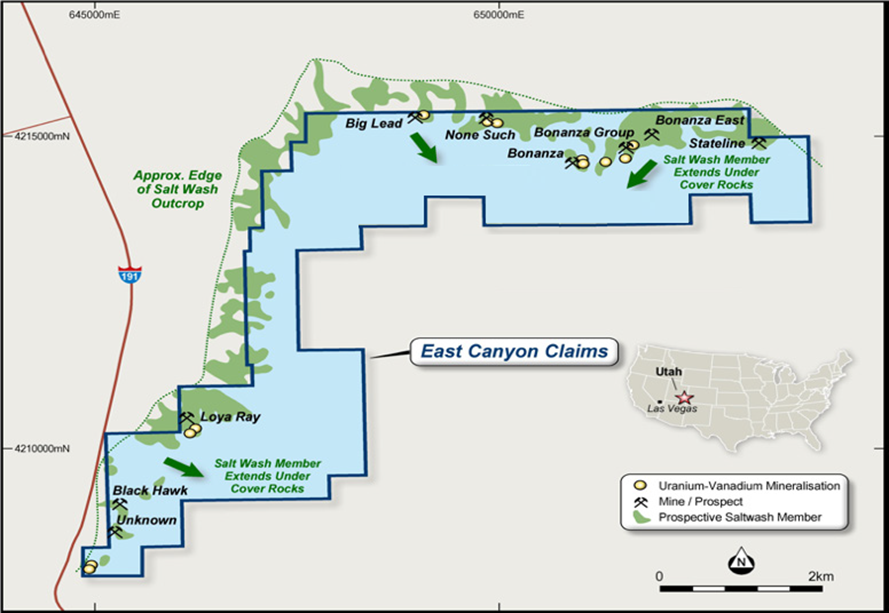The East Canyon uranium-vanadium project comprises 231 contiguous claims (~4620 acres/18.7km2) prospective for uranium and vanadium in the Dry Valley/East Canyon mining district of south-eastern Utah, USA (the Claims).
History
The Uravan Mineral Belt and surrounding Salt Wash ore producing districts of the Colorado Plateau, which hosts the Claims, has been an important source of uranium and vanadium in the US for more than 100 years, with historic production of more than 85 million pounds of uranium at an average grade of more than 0.13% U3O8 and more than 440 million pounds of vanadium at an average grade of 1.25% V2O5.
The Project is an area with known historical workings, historic drill intercepts and historic production of both uranium and vanadium. Many of these workings remain open, accessible and in good condition with visible high grade uranium-vanadium mineralisation present.
These samples assayed as high as 0.47% U3O8 and 9.21% V2O5. Abundant visible uranium-vanadium mineralised seams and zones were also observed in the workings.
Extensive workings were identified at Bonanza prospect and visible uranium and vanadium mineralisation was observed throughout both prospects. Extremely high handheld scintillometer readings were observed and associated with visible uranium mineralisation. Rock chip and channel samples were assayed along with mapping data, and numerous historical drill holes were identified.
Results
Encouraging high grade assay results returned from initial drilling include:
- 2.13m @ 0.105% U3O8 from 40.84m;
- 1.5m @ 1.04% V2O5 from 41.15m;
Subsequent Work
Radiometric and Magnetic surveys have identified large uranium anomalies at East Canyon. Field mapping and sampling exploration work continues to help define priority drill targets.
District Activities
The district hosts several significant uranium-vanadium operations including TSX-listed Energy Fuels Inc.’s La Sal Complex mines and development projects, International Consolidated Uranium’s Rim/Columbus and Sage Plains project which was subject to a recent acquisition and strategic alliance with Energy Fuels, and Velvet-Wood, owned by TSX-V-listed company Anfield Resources.
Energy Fuels’ White Mesa Mill, the only fully licensed and fully operating conventional uranium-vanadium mill in the US, is located within trucking distance (50km) of the East Canyon Project along major highway 191.
Energy Fuels has historically accepted toll treatment agreements as well as purchase programmes for processing ores from third-party mines. This may represent a low-cost opportunity for developers in the region to utilise existing infrastructure, eliminating the significant capital requirement of developing a mill. There is currently no relationship or arrangement in place between Energy Fuels and Red Dirt or the Company.
Uranium and vanadium-bearing deposits in the Dry Valley/East Canyon district are confined to the Salt Wash Member of the Morrison Formation. This unit consists of interbedded fluvial sandstone and flood plain-type mudstone units. The sandstone beds crop out in three distinct rims with the mudstones forming the slopes. The uppermost sandstone of the three rims, contains the majority of the ore deposits, but deposits do occur in the lower sandstones.
These sediments are classified as orthoquartzites to feldspathic orthoquartzites. Sedimentary structures, such as cross-bedding and channel scouring, are displayed and contain carbonaceous plant debris, clay galls, and interbedded siltstones and mudstones.
They are generally interpreted to have been deposited by braided and meandering stream systems. Typically, they are light-coloured, permeable, medium to fine-grained sands with occasional conglomeratic zones. Thickness of these three rims averages between 15-60 feet and may be up to several thousand feet long. They are separated by a near equal amount of alternating red and grey mudstones. In some localities these rims or lenses may have scoured into the sands below.
The uranium-vanadium ore deposits are hosted in reduced greys and stones which are characterised as being elongated, parallel to sedimentary trends and are concordant with the bedding. Mineralisation occurs in tabular topod-like bodies within the sandstone that may range from <1-10+ feet thick. As the nature of these deposits can be spotty and discontinuous so is the variance in grade.





